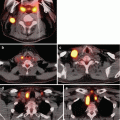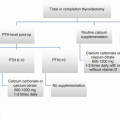Candidates for observation
Tumor characteristics
Patient characteristics
Medical team characteristics
Ideal
Solitary nodule, well-defined border, surrounded by thyroid normal thyroid tissue, stable on ultrasound, no ETE= Extrathyroidal extension, no evidence of metastatic disease
> 60 years old, select observation with understanding future surgical intervention possible, compliant with follow-up, support system, nonsurgical candidate secondary to comorbidities
Experienced multidisciplinary team, experienced ultrasonographer, prospective data collection, system in place to assure appropriate follow-up
Appropriate
Multifocal, subcapsular position away from RLN, features associated with difficult follow-up (thyroiditis, multiple thyroid nodules), PET-avid disease
Middle age, strong family history of thyroid cancer, child-bearing potential
Experienced thyroid surgeon or endocrinologist, neck ultrasonography available
Inappropriate
Aggressive histology, located subcapsular adjacent to RLN, ETE=extrathyroid extension, invasion into adjacent structures, metastatic disease
<18 years old, not likely to be compliant with follow-up, unwilling to select observation strategy
Limited experience with thyroid cancer management, neck ultrasonography not available
The ATA guidelines now state that, although surgery is generally recommended for biopsy-proven thyroid cancer, an active surveillance management approach can be considered as an alternative to immediate surgery [16]. Whether this protocol can be implemented and be successful in other settings is currently under investigation.
Summary
PTMC is on the rise. The evidence suggests that this increase in incidence is associated with an increase in diagnostic scrutiny. Therefore, we need to examine how we manage this disease, which in most cases is indolent. Molecular markers will likely, one day, aid in the decision-making of which neoplasms need to be aggressively treated and which may be actively observed. At present, it is safe and effective to manage PTMCs conservatively, with active surveillance only, for appropriate patients, following the use of a risk-stratified, evidence-based approach. With the increased use of diagnostic modalities in the primary care setting, an in-depth understanding of the natural history of PTMC is important in the management of this now common—however, rarely deadly—clinical entity.
Disclosures
The authors have no conflicts of interest or financial disclosures.
References
1.
2.
3.
4.
5.
6.
7.
8.
9.
Bondeson L, Ljungberg O. Occult thyroid carcinoma at autopsy in Malmo. Swed Cancer. 1981;47(2):319–23.PubMed
12.
13.
Bahl M, et al. Trends in incidentally identified thyroid cancers over a decade: a retrospective analysis of 2,090 surgical patients. World J Surg. 2014;38(6):1312–7.CrossRefPubMed
Stay updated, free articles. Join our Telegram channel

Full access? Get Clinical Tree






